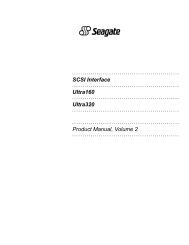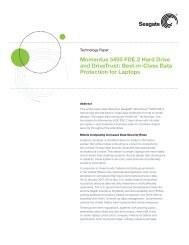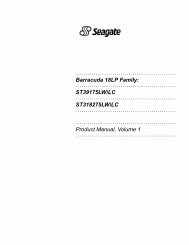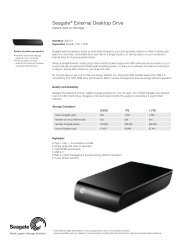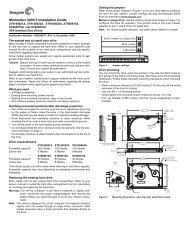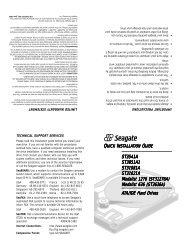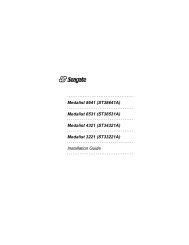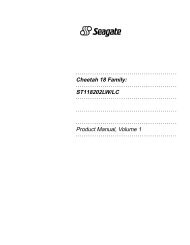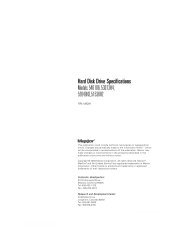Quickview 300 Product Manual PATA - Seagate
Quickview 300 Product Manual PATA - Seagate
Quickview 300 Product Manual PATA - Seagate
You also want an ePaper? Increase the reach of your titles
YUMPU automatically turns print PDFs into web optimized ePapers that Google loves.
GLOSSARY<br />
A<br />
ACCESS – (v) Read, write, or update<br />
information on some storage medium, such as<br />
a disk. (n) One of these operations.<br />
ACCESS TIME – The interval between the<br />
time a request for data is made by the system<br />
and the time the data is available from the<br />
drive. Access time includes the actual seek<br />
time, rotational latency, and command<br />
processing overhead time. See also seek,<br />
rotational latency, and overhead.<br />
ACTUATOR – Also known as the positioner.<br />
The internal mechanism that moves the<br />
read/write head to the proper track. The<br />
Maxtor actuator consists of a rotary voice coil<br />
and the head mounting arms. One end of each<br />
head mounting arm attaches to the rotor with<br />
the read/write heads attached at the opposite<br />
end of each arm. As current is applied to the<br />
rotor, it rotates, positioning the heads over the<br />
desired cylinder on the media.<br />
ALLOCATION – The process of assigning<br />
particular areas of the disk to particular files.<br />
See also allocation unit.<br />
ALLOCATION UNIT – An allocation<br />
unit, also known as a cluster, is a group of<br />
sectors on the disk that can be reserved for the<br />
use of a particular file.<br />
B<br />
BACKUP – A copy of a file, directory, or<br />
volume on a separate storage device from the<br />
original, for the purpose of retrieval in case the<br />
original is accidentally erased, damaged, or<br />
destroyed.<br />
BAD BLOCK – A block (usually the size of<br />
a sector) that cannot reliably hold data because<br />
of a media flaw or damaged format markings.<br />
BAD TRACK TABLE – A label affixed to<br />
the casing of a hard disk drive that tells which<br />
tracks are flawed and cannot hold data. The<br />
listing is typed into the low-level formatting<br />
program when the drive is being installed.<br />
Because Maxtor disk drive’s<br />
defect-management scheme handles all such<br />
flaws automatically, there is no need to<br />
concern yourself with bad track tables.<br />
BIT – Abbreviation for binary digit. A binary<br />
digit may have one of two values—1 or 0.<br />
This contrasts with a decimal digit, which<br />
may have a value from 0 to 9. A bit is one of<br />
the logic 1or logic 0 binary settings that make<br />
up a byte of data. See also byte.<br />
BLOCK – A sector or group of sectors. By<br />
default, a block of data consists of 512 bytes.<br />
AVERAGE SEEK TIME – The average<br />
time it takes for the read/write head to move<br />
to a specific location. To compute the average<br />
seek time, you divide the time it takes to<br />
complete a large number of random seeks all<br />
over the disk by the number of seeks<br />
performed.<br />
<strong>Quickview</strong> <strong>300</strong> 80/100/120/160/200/250/<strong>300</strong>GB <strong>PATA</strong> G-1



